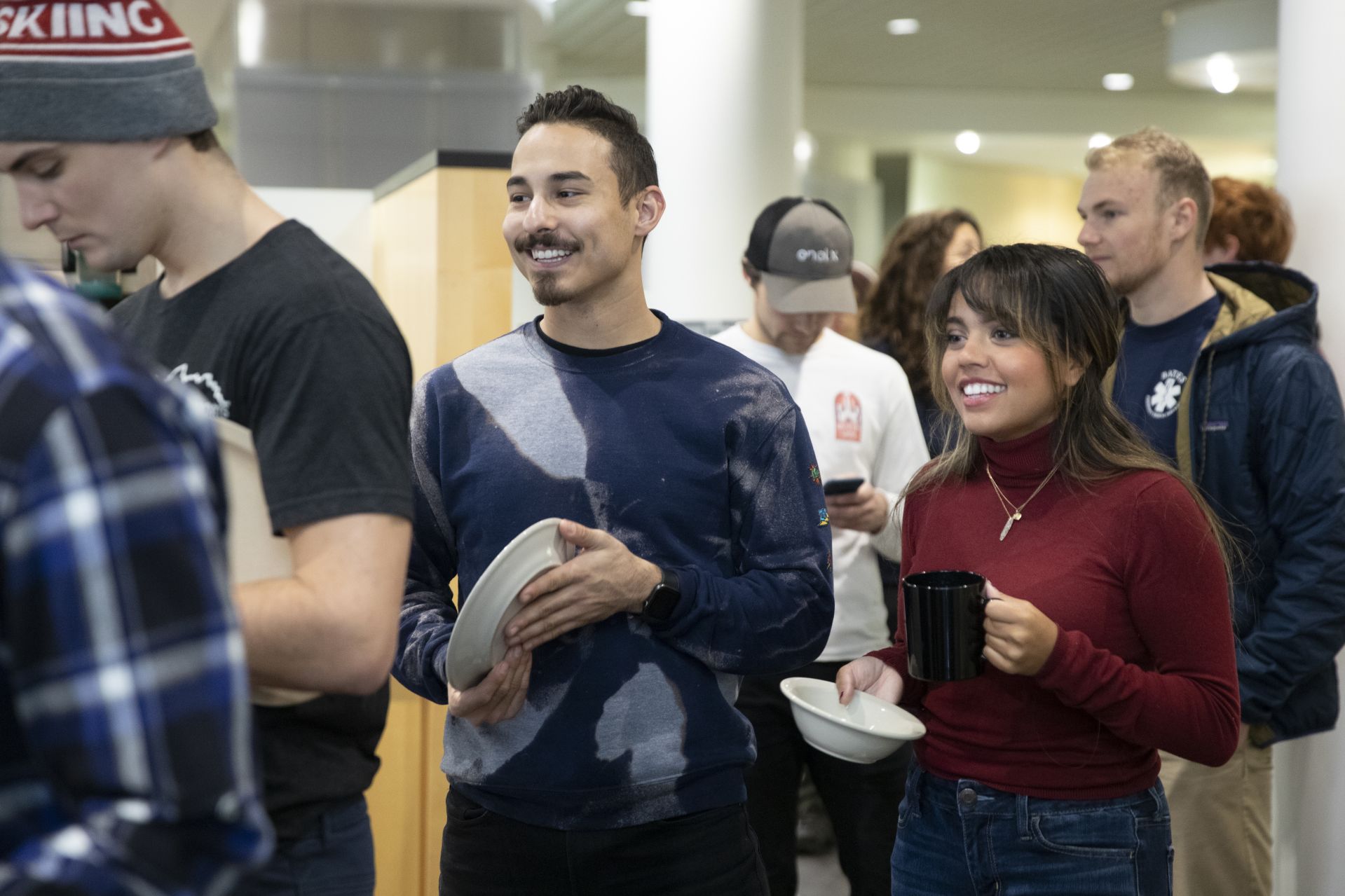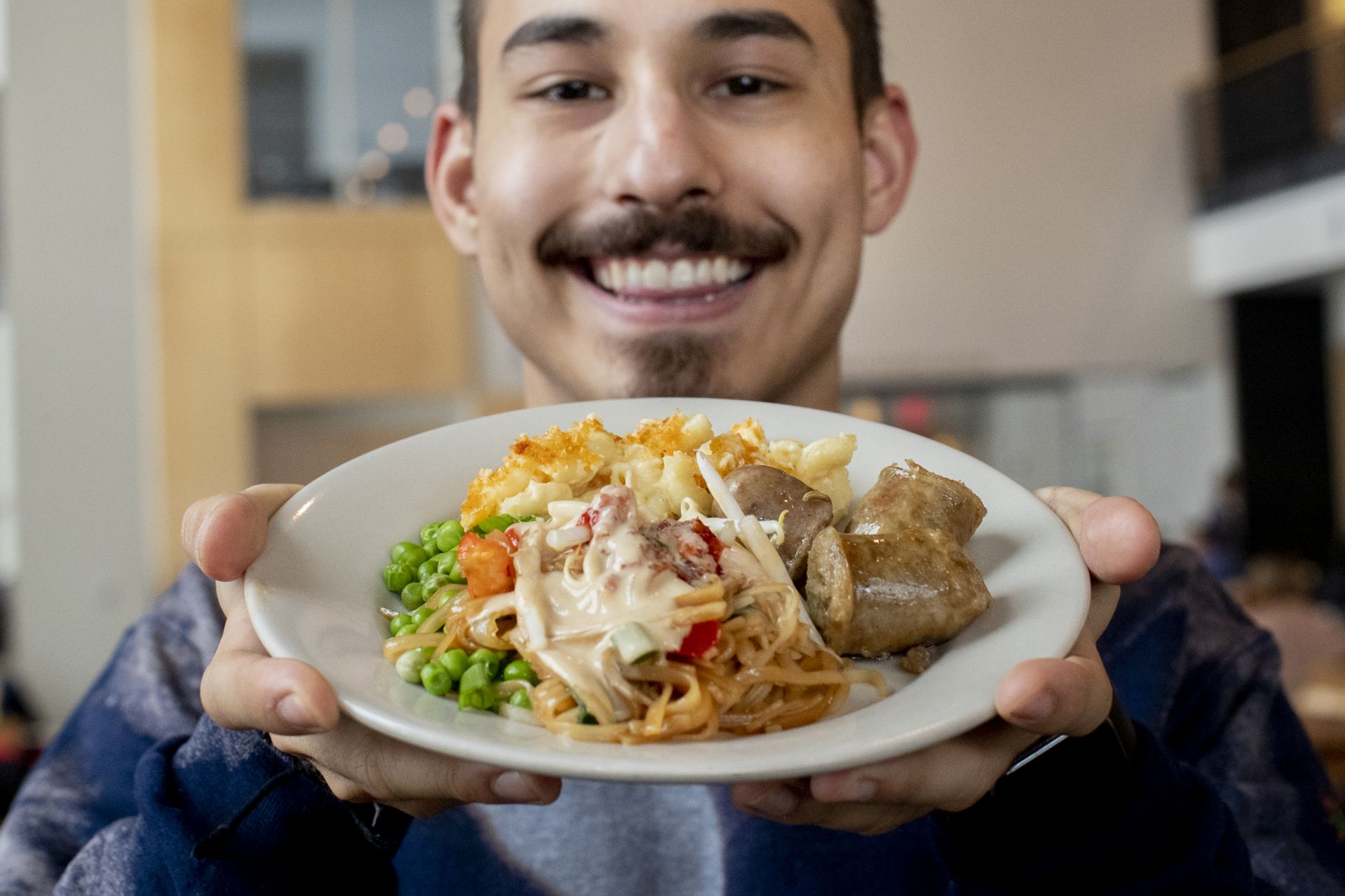
Last Monday, students returning to Bates for the winter semester had the usual variety of lunch options at Commons. From the brick oven station, a diner could grab a slice of thick-crust cheese pizza, then head over to the Bobcat Bar for a serving of shrimp scampi. For dessert, a lemon pudding bar.
Thanks to NetNutrition, a comprehensive online nutrition guide that Bates implemented during the fall, it’s possible to know exactly what’s in that meal: 59 grams of carbohydrates, for example, plus 1.6 grams of dietary fiber, 8.8 grams of protein, and 16% of the recommended daily amount of Vitamin C.
“It’s enhanced our program, not only for those who have special dietary needs but also for students in general, because it provides much more information at a touch,” says Christine Schwartz, assistant vice president for the Dining, Conferences, and Campus Events office.
Bates has long worked to educate diners about what’s in the food it serves, posting allergen information on physical cards near the food for people who need to avoid things like dairy or tree nuts and making sure dining staff are available to answer questions.
In turn, students have a voracious interest in their food, making the online menu typically among the most heavily trafficked Bates websites.
NetNutrition leverages the popularity of the online menu by adding, for the first time, information about allergens, calories, carbs, fat, protein, and vitamins and minerals.
“We’ve packaged it into one spot,” Schwartz says.

At lunch on Jan. 16, Andrew Garcia-Bou ‘20 of Eastchester, N.Y., and Ke’ala Brosseau ‘20 of Burlington, Vt., both student employees in the Bates Communications Office, have gamely agreed to display their Commons creations before chowing down. (Phyllis Graber Jensen/Bates College)
The software, a product of inventory management company CBORD, functions as a feature of Commons’ existing online menu — curious or conscientious diners can simply click on an item like sweet and sour sauce or Frosted Flakes to see the nutritional information, they can “build a meal” from multiple items, or they can look ahead to future days’ offerings.
Bates is one of the smallest colleges to use NetNutrition, Schwartz says, and it took about two years to fully implement the program.
That’s because dining staff had to track down nutritional information for each ingredient in each recipe on Commons’ five-week menu cycle, weigh and measure the items, and account for when food expands or shrinks as it cooks. In total, they coded about 4,000 data points.
They also revisited handwritten recipes to make sure they reflected changes over the years and revised serving sizes to reflect how much people actually eat. For example, the serving size on a box of pasta might not be the same as a standard spatula-ful at the pasta bar.
“We had to have our vendors learn how we track things,” says David Perreault, associate director of dining. “If we thought a bulk item weighs 10 pounds, and it really weighs 12, we’d have to make that adjustment so the portions were correct.”

Ke’ala Brosseau ‘20 of Burlington, Vt., poses with her lunch, a bowl of vegan pad thai with bean sprouts, scallions, soy sauce, and chili garlic sauce topped with paprika and lime. According to the NetNutrition guide, the meal nets about 18% of the daily recommended amount of sodium and 2.7 grams of dietary fiber — though those allergic to soy might want to pick something else. (Phyllis Graber Jensen/Bates College)
One semester in, things don’t look all that different in the Commons dining hall. Allergens are still posted at each food station, but nutritional information is not.
“Our feeling is that if you post nutritional information — if you make it prominent in the dining hall — that would be a detriment to students who might have issues with food,” says Director of Dining Cheryl Lacey. Adds Schwartz, “We have never put the calorie information on a card, and we never will.”
Instead, NetNutrition enables students to independently check calories, carbs, and ingredients of their meals.
The guide has already been the subject of a senior thesis. Lauren Hernandez ’20, a psychology major from Chester, N.J., looked at how students use NetNutrition and whether or not their use reflects a healthy relationship with food.
Because not enough of the 200-plus students Hernandez surveyed use NetNutrition, she couldn’t draw a definitive conclusion about their relationships with food. She did find, however, that those who do use it find it helpful for planning their meals around dietary restrictions or spotting allergens.
For dining staff, meanwhile, NetNutrition has been revolutionary. Not only can individual diners access nutritional information, but the centralized software has made it easier for Dining Services’ purchasers, chefs, and managers to communicate with each other.

Andrew Garcia-Bou ’20 shows off his lunch, a plate of macaroni and cheese, Italian-style pork sausage, vegan pad thai, and peas. The meal contains just under a gram of trans fat and a quarter of the recommended daily amount of iron, according to NetNutrition. Allergens and dietary restrictions to watch out for are soy, dairy, and, of course, pork. (Phyllis Graber Jensen/Bates College)
Allergen notices have become automated, chefs can modify recipes and have the nutrition information automatically update, and staff on the floor can more easily guide students who have dietary questions.
“This is a safety net,” says Sous Chef Michael Staffenski. “A student comes to me and says, ‘Does this have bean sprouts in it?’ I don’t know every recipe. Instead of running around to find out, I can say, ‘Yeah, it does’ or ‘It doesn’t.’”
Kelly Perreault, a senior administrative coordinator and special dietary needs liaison, says NetNutrition is one of many ways students and other diners can know what they’re eating, make meals to suit their individual needs, and — especially for those with allergies — to make sure they’re eating safely.
“Their best tool,” she points out, “is actually getting to know our cooks, approaching somebody at the grill and saying, ‘Hey, I’m allergic to this — can I see the menu?’
“NetNutrition is one of many tools for students to know that this is their home away from home, and it’s necessary to feel safe in their environment,” she says. “Our office doors are always open to talk to myself or anyone else.”



